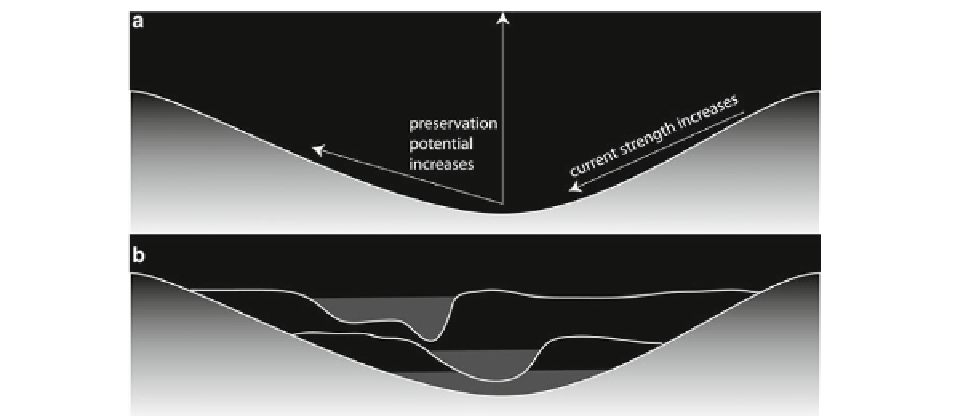Geology Reference
In-Depth Information
Fig. 14.16
Cartoons illustrating preservation potential within
a submarine canyon. (
a
) Preservation potential increases both
towards the margins and upward within the fi ll of a submarine
canyon. (
b
) Cartoon showing axial coarse clastics (
dark gray
),
and fi ner-grained overbank (
white
). Tidalites are much more
likely to be preserved in the upper part of the submarine canyon
fill because the energy in the system is lower (the fill is
generally moved under lower energy conditions than whatever
currents cut the canyon), and because the currents have further
to spread out laterally, decreasing the amount of energy avail-
able per unit volume even further than lower down in the sub-
marine canyon
topographic low, and deposited the reworked sediment
into that low. Subsequently another turbidite was
deposited, both within the low and on the surrounding
seafl oor, which then was also reworked and deposited
by tidal currents into the low (Fig.
14.15d
). This was
repeated episodically until the low was fi lled. In
between periods of sediment availability tidal currents
undoubtedly continued to pump up and down the sub-
marine canyon, but without sediment to rework the
only record of that are intervals of greatly increased
bioturbation (see the top of the tidalite intervals in
Fig.
14.13
as an example).
present in a submarine canyon at the same time as
powerful turbidity currents and debris fl ows.
Additionally, Shanmugam (
2003
) suggested that the
tops of many beds throughout the Peira Cava outlier of
the Annot Formation (Amy et al.
2007
) were reworked
by tidal currents. Although I disagree that all or even
most of the beds in the Peira Cava area with rippled
tops are reworked by tidal currents, the apparent unsys-
tematic occurrence of potential tidalites within any
given sequence suggests there may not be a strong
external control on their preservation. Perhaps only
local conditions such as accommodation space, are
important.
The strength of surface tides during times of low-
ered sea-level with the same plate confi guration has
been calculated to increase, potentially by 50% or
more (Egbert et al.
2004
; Hall and Davies
2004
; Neill
et al.
2010
; Uehara et al.
2006
). In addition, the dissi-
pation of tidal energies in the deep oceans has been
shown to increase during lowered sea-level, with
1.25-3 times more energetic deep ocean internal tides
globally during the Last Glacial Maximum than at
present (Egbert et al.
2004
) , when sea-level was
between 120 and 140 m lower than today (Adkins et al.
2002
; Lambeck and Chappell
2001
) . Although based
on modeling, this result suggests that a eustatic cycle
14.8
Sequence Stratigraphy
Zhenzhong and Eriksson (
1991
) developed a sequence
stratigraphic model based on the Ordovician Bays
Formation, Virginia. They suggested that internal tidal
deposits are best preserved during the late transgres-
sion or early highstand part of a sea-level cycle. May
et al. (
1983
) also showed that tidal current indicators
were more common in the upper part of a submarine
canyon fi ll, although they did not put this into a strict
sequence stratigraphic framework. Shanmugam et al.
(
2009
) interpreted internal tidal deposits to have been

